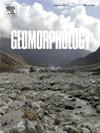在快速消冰地形中,微尺度地形对功能性山坡-河流连通性的控制
IF 3.1
2区 地球科学
Q2 GEOGRAPHY, PHYSICAL
引用次数: 0
摘要
自小冰期结束以来,高山冰川的迅速退缩增加了原冰期边缘的空间范围。虽然冰川对气候变暖的响应有充分的文献记载,但对前冰期景观的响应,特别是对沉积物转移过程的响应却知之甚少。泥沙运输通过侵蚀和沉积改变了景观并影响了泥沙的连通性。后者可以被描述为结构(静态,与系统的配置有关)或功能(动态,由沉积物通量的时空变化引起)。本文量化了最近冰川消融的高寒山坡沉积物通量的功能连通性。高分辨率数字高程模型的分析与形态学方法相结合,以评估在季节和多年时间尺度上保持质量所需的泥沙通量的空间格局。结果表明,功能连通性受消冰期和消冰期后发育的山坡微尺度地形的强烈控制。因此,功能连通性是决定沉积物在冰川退缩后最终由原冰川流输送到谷底的关键因素。这种效应在季节时间尺度上比在多年时间尺度上更强。本文章由计算机程序翻译,如有差异,请以英文原文为准。
Micro-scale topographic controls on functional hillslope-to-stream connectivity in rapidly deglaciating terrain
Rapid retreat of Alpine glaciers since the end of the Little Ice Age has increased the spatial extent of proglacial margins. Whilst the response of glaciers to climate warming is well-documented, the response of proglacial landscapes, especially regarding sediment transfer processes, is less understood. Sediment transport, through erosion and deposition, modifies the landscape and affects sediment connectivity. The latter may be described as structural (static, related to the configuration of the system) or functional (dynamic, resulting from time-space variation in sediment flux). This paper quantifies the functional connectivity of sediment flux for a recently deglaciated Alpine hillslope. Analysis of high-resolution digital elevation models is coupled to a morphological method to assesses the spatial pattern of sediment flux required to conserve mass over a seasonal and a multi-year time-scale. Results show that functional connectivity is strongly controlled by micro-scale topography on the hillslope that has developed during and since deglaciation. Functional connectivity is then a key factor determining the delivery of sediment to the valley bottom for eventual transport by the proglacial stream following glacier retreat. This effect is stronger at the seasonal time-scale than at the multi-year time-scale.
求助全文
通过发布文献求助,成功后即可免费获取论文全文。
去求助
来源期刊

Geomorphology
地学-地球科学综合
CiteScore
8.00
自引率
10.30%
发文量
309
审稿时长
3.4 months
期刊介绍:
Our journal''s scope includes geomorphic themes of: tectonics and regional structure; glacial processes and landforms; fluvial sequences, Quaternary environmental change and dating; fluvial processes and landforms; mass movement, slopes and periglacial processes; hillslopes and soil erosion; weathering, karst and soils; aeolian processes and landforms, coastal dunes and arid environments; coastal and marine processes, estuaries and lakes; modelling, theoretical and quantitative geomorphology; DEM, GIS and remote sensing methods and applications; hazards, applied and planetary geomorphology; and volcanics.
 求助内容:
求助内容: 应助结果提醒方式:
应助结果提醒方式:


